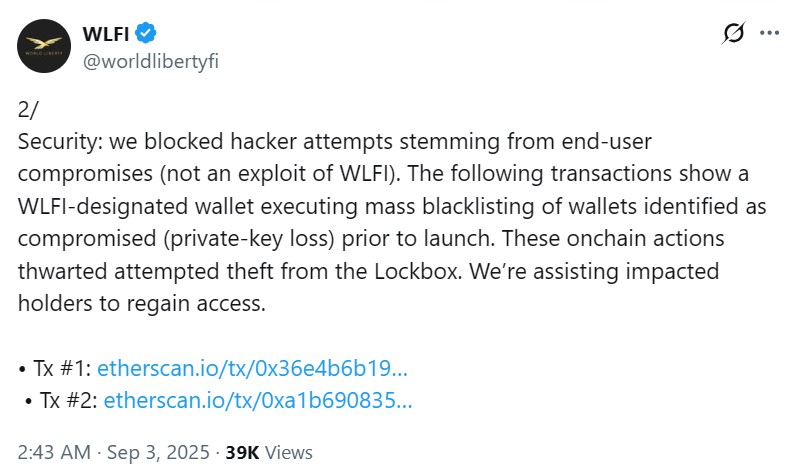WLFI’s onchain blacklisting blocked multiple theft attempts by disabling wallets identified as compromised before trading began, using a designated wallet to execute mass blacklisting and safeguarding the project’s Lockbox vesting allocations.
-
Onchain blacklisting stopped theft attempts
-
WLFI identified compromised wallets tied to private key losses and blocked them before launch.
-
Analytics and security firms (Bubblemaps, SlowMist) flagged clone contracts and an EIP-7702 phishing vector.
WLFI blacklisting prevented token theft by disabling compromised wallets before launch — learn recovery steps and security tips now.
DeFi project WLFI said its onchain blacklisting efforts have thwarted theft attempts stemming from compromised end-users.
World Liberty Financial (WLFI) reported that a designated wallet executed “mass blacklisting” transactions to disable compromised accounts onchain before token trading opened. The team emphasized these incidents resulted from end-user compromises—such as private key loss—and were not caused by an exploit of WLFI’s protocol.

What did WLFI’s blacklisting accomplish?
WLFI blacklisting disabled wallets flagged as compromised, blocking attempts to drain the project’s Lockbox vesting allocations and preventing unauthorized transfers during the token launch. The team confirmed recovery assistance is underway for affected users.
How were compromised wallets identified?
WLFI said the team used transaction monitoring and manual review to flag accounts linked to private key loss or suspicious patterns. The project cited onchain heuristics and reports from analytics observers to compile a blacklist prior to trading.
Why did attackers target WLFI users?
Attackers exploited look-alike smart contracts and an EIP-7702 phishing vector that allows offchain-signed actions. Fraudsters used bundled clones to lure users to fake contracts and planted malicious addresses in wallets to siphon tokens on deposit.
What role did EIP-7702 and the Pectra upgrade play?
EIP-7702 (introduced with Ethereum’s Pectra upgrade) lets externally owned accounts temporarily delegate execution rights, enabling batch operations. Security researchers reported a phishing vector where an offchain signature can be misused to trigger token transfers without a direct onchain approval.
How is WLFI helping affected users?
The WLFI team is working directly with compromised holders to restore access where possible. They advised users to follow wallet-recovery best practices, rotate credentials, and avoid interacting with unverified contracts. Public references: Etherscan transaction logs, Bubblemaps, SlowMist, and security auditor Arda Usman.
Frequently Asked Questions
How can WLFI holders recover funds after a compromise?
WLFI is coordinating recovery with compromised users. Holders should provide transaction evidence, follow the project’s recovery instructions, and secure any remaining assets in new wallets with fresh keys.
Can blacklisting be abused?
Blacklisting carries governance and custody risks. Projects must publish clear policies and minimal centralized controls to balance user protection with decentralization principles.
Is EIP-7702 safe for regular users?
EIP-7702 offers UX benefits but introduces an offchain signature attack surface. Users should avoid authorizing untrusted transactions and use hardware wallets or multisig where possible.
How to recover and secure your WLFI holdings
Follow these prioritized steps to reduce risk and recover access.
- Contact WLFI support and provide transaction hashes for affected accounts (plain-text references to Etherscan are recommended).
- Move unaffected assets to a new wallet with fresh private keys and seed phrases stored offline.
- Revoke approvals and avoid interacting with cloned contracts flagged by analytics sources such as Bubblemaps.
- Use hardware wallets or multisig solutions to reduce single-key compromise risk.
- Monitor official WLFI announcements and security reports from firms like SlowMist and auditors like Arda Usman (plain-text references).
Key Takeaways
- Immediate prevention: WLFI’s mass onchain blacklisting blocked theft attempts targeting the Lockbox.
- Primary risk: Compromised end-user wallets and EIP-7702 phishing vectors, not a protocol exploit.
- Action items: Affected users should follow WLFI recovery steps, move funds, and adopt hardware wallets or multisig.
Conclusion
WLFI’s onchain blacklisting mitigated immediate theft risks by disabling compromised wallets and protecting the Lockbox vesting mechanism. Security experts cite EIP-7702 and clone-contract phishing as key threats; affected holders should follow recovery and hardening steps. COINOTAG will monitor updates and report developments.
